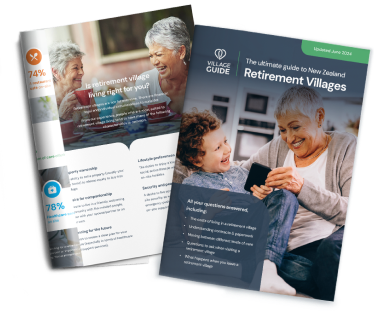
Across New Zealand, retirement village living is growing in popularity.
According to a report produced by real estate firm JLL, the number of retirement villages across New Zealand has grown by 32% in the ten years to 2022, while the number of dwellings within these villages has increased by 79% in the same period.
Despite this growing popularity, many people are still unaware of what it’s like to move into, and live in, a retirement village dwelling - and how this is different to the regular home market.
We’ve broken down the 12 key differences between a retirement village and regular dwelling.
Difference one - Like-minded community and services
This difference is reasonably well-known, but worth re-stating upfront given it’s why most people are considering moving into a retirement village in the first place.
When you move into a retirement village, you’re joining a community which has been established to specifically support and connect retirees, who are able to live fully independently or with some regular domestic assistance.
This means retirement villages provide well-designed and safe dwellings alongside services such as community transport, events and entertainment, private open space, fitness facilities, meals and 24-hour emergency medical monitoring.
These dwellings and services increase the chances that a village resident will be mentally and physically stimulated, healthy and connected.
Equally so, residents within retirement villages typically also informally look after each other, breaking down loneliness and creating caring, supportive networks.
A regular home or apartment however is less likely to have the same like-minded community (and community services) in place.
This means that it is possible that a retiree living in the general community will be more isolated, and less mobile and active, compared to living in a retirement village.
Find out more:
What to expect when you move into a retirement village
Twelve health benefits of living in a retirement village
Difference two - Purchasing process
The process for purchasing a retirement village is quite different to the process involved in buying a regular home.
Typically, this involves choosing your village and village dwelling, paying a refundable deposit to secure the dwelling and then signing an occupation right agreement.
It is usually easier to move into a retirement village after selling your regular home, compared to moving between regular homes.
This is because retirement village operators recognise that people typically need to sell their existing home to move into a retirement village, and sometimes this can take time and unexpected twists and turns. The story at the link below explains this further.
Find out more: The purchasing process for retirement village dwellings
Difference three - Land title versus occupancy right
When buying a regular house or apartment, your ownership of this property - and right to occupy it - are guaranteed through your name being placed on a land title.
The situation is different when buying into a retirement village.
Retirement village dwelling purchasers in New Zealand are, in the vast majority of cases, entering into an ‘occupation right agreement’.
This means that, in most cases, incoming residents are purchasing the right to occupy a dwelling, with this right guaranteed through the legal agreement signed with the retirement village operator. However, the purchaser’s name will not appear on a land title for this dwelling (or the land underneath it).
This ‘occupation right agreement’ model is used because it supports the value proposition of retirement villages, which is to provide age-appropriate accommodation, services and facilities. The agreement - and other documents provided to incoming residents - explain all the services and facilities offered by the operator, and relevant fees.
Such an agreement is typically not needed when buying a regular home, given the same services and facilities are not being provided.
Find out more:
Understanding retirement village contracts and paperwork
Difference four - Home insurance and taxes
When you buy a regular house or apartment, you are typically directly responsible for council and water rates, and energy costs, and can choose whether to pay for home insurance (both for the building and contents).
In a retirement village, council and water rates, and insurance for dwelling structures, are usually paid for the operator and then charged to all purchasers through a regular fee
Residents however generally pay their own home contents insurance (if they choose) and energy costs.
Find out more:
The costs of living in a retirement village
Insurance requirements for retirement village operators
Everything you need to know.
Difference five - Deferred management fee
As noted above, when you buy into a retirement village, you are effectively buying into a like-minded and supportive community.
The retirement village property purchase model is designed to also support this community.
In particular, retirement village dwelling contracts typically include a requirement to pay a deferred management fee (but this may be called a different name such as retention fee).
The deferred management fee is typically valued at around 20-30% of your purchase cost.
The deferred management fee may be used for a range of purposes by the village operator, including paying for upgraded and expanded facilities, refurbishing vacated dwellings and also putting money into reserves to be used for unexpected events.
By doing this, it can continue to look after the retirement village for the benefit of all residents, both existing and future residents.
Given that purchasing a regular home doesn’t have this same communal focus, a deferred management fee does not apply.
Find out more: The costs of living in a retirement village
Difference six - Ongoing fees
In a regular detached home, you won’t need to pay ongoing fees to maintain your property (although to be a responsible homeowner you should be voluntarily setting aside this money). If you live in an apartment, such a fee will apply to maintain common property.
Retirement villages also have ongoing fees, to cover day-to-day operating costs such as rates, insurance, grounds maintenance, staff wages and village services.
The fee amount (and what’s included) varies significantly from village to village, so be sure to ask the sales manager for details.
Find out more: The costs of living in a retirement village
Difference seven - Capital gain and loss
When you sell a regular home or apartment, you will receive all capital gains (or alternatively losses) accrued since purchasing the dwelling.
The situation is different when you leave a retirement village dwelling.
While there are different approaches across the New Zealand retirement village industry, in most cases you will be returned the amount you paid to enter the dwelling, minus the deferred management fee.
The operator will typically bear the burden or any losses, or alternatively the benefit of gains.
However, some operators do offer capital gains, so it is worth closely checking the proposed contract and deciding on the model which works best for you.
Find out more: Capital gains and losses: key things to know
Difference eight - Sale process
The purchase and sale process for a regular home or apartment is well-known, with most people using a real estate agent to sell their home either via an offer or auction system. Sellers need to negotiate a fee arrangement with the agent.
In a retirement village, however, you will be typically using the village sales representative when buying and selling your unit.
This is because these sales representatives are experts in understanding the village and the purchasing process, which is not the case with a regular agent.
Find out more: Leaving a village: How does the sale process work
Difference nine - Borrowing
In later life, many people are free of mortgages, or not in a position to raise a mortgage.
Despite this, it’s important to know that, when you buy a retirement village dwelling, you are generally not in a position to borrow against that purchase (although in some circumstances operators may allow you to borrow against the termination payment due to the resident when they leave the village).
This is different to the situation for regular homes and apartments, where it is possible to raise a mortgage against the land title, subject to lender approval.
Difference ten - Family and friends staying over
In a regular home or apartment, the purchaser is free to determine who stays in the property.
In a retirement village, not surprisingly, there can be rules as to who is allowed to live in the village. The village is, after all, meant to cater for retirees, not the general population.

Most villages allow for friends and family to have temporary stays (and actively encourage this) but visitor policies vary from village to village. Be sure to ask the sales manager about their policy towards visiting friends and family.
Difference eleven - Renting out or sub-letting
Most retirement villages do not allow sub-letting or rental of a unit, given the licence to occupy is assigned to a certain person (but not tenants).
This outcome also means that a retirement village can provide a stable community, and that community reflects the purpose of the village which is to cater for retirees.
This is, of course, different to a regular home or apartment where the owner is free to rent or sub-let the dwelling to whom they choose.
Difference twelve - Care
Increasingly, retirement villages contain both independent living dwellings and rest homes, with residents of the independent living dwellings often getting priority access to the rest home rooms or suites when the time comes.
This same level of access may not be available to people living in regular homes, who are trying to access the village for the first time.
Find out more: A step-by-step guide to residential care
Conclusion
While there are many differences between a retirement village and a regular home, there is one key thing which is the same.
And that is, when living independently in a retirement village dwelling, as with a regular home, you are free to come and go as you please.
It’s just that you may have more friends who’ll wave you goodbye and you head out to lunch or the cinema, compared to living in a regular home.
To find out more about retirement villages, head to the Village Guide resource centre
Disclaimer: Please note this story has been prepared as a general guide only, and should not be relied upon as a substitute for seeking your own independent legal and financial advice and asking your own questions


